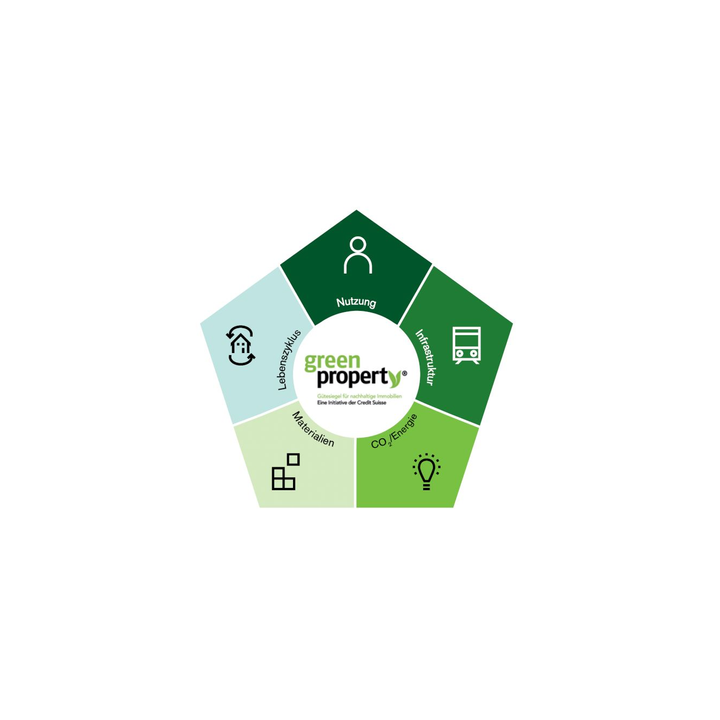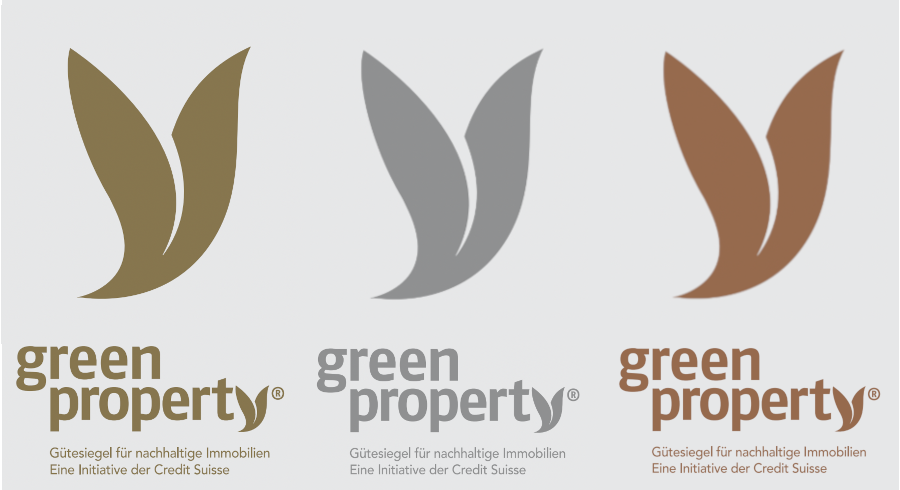greenproperty Criteria
Which parts of the property’s performance are evaluated for the greenproperty certification?
For the greenproperty certification, ecological, economic and social criteria are assessed in five different aspects. These aspects are divided into different criteria and around 50 indicators, that must be checked for every construction project. The five greenproperty aspects influence the assessment in equal parts: each aspect is weighted with 20%.
Aspects:
- Use
- Infrastructure
- Life Cycle
- Materials
- CO2/Energy
The specified criteria stand for different areas within the individual aspects. For each aspect, five standard criteria and one innovation criterion are defined. Each criterion makes up 4% of the total rating. In each aspect there is a sixth criterion named “Innovation”, through which the degree of fulfillment within a single aspect can be improved by 5%. The innovation criterion can change annually and thus promotes both proven and new ways and solutions.
In turn, up to four indicators are defined for the individual criteria, on the basis of which the projects are evaluated. Depending on the number of indicators, these make up 1 to 4% of the overall rating. Some indicators are marked as situation indicators. Their rating depends on the property or the location. The results here can sometimes be improved by employing measures appropriate to the property.
To meet the individual indicators, single or multiple measures are formulated, which are defined and published once a year.
How does the greenproperty certification progress work?
If a property or a construction project is to receive greenproperty certification, a multi-stage assessment process must be carried out. The fullfillment of economic and sustainability criteria is reviewed during the planning and acquisition phase and a provisional seal of approval (gold, silver or bronze) is issued if the test is passed successfully.
There are no minimum requirements for individual criteria that have to be met here – it makes sense, however, to include the certification intention in the planning from the start, as the provisional seal of approval is awarded in the planning phase. The evaluation in the area of use in particular is strongly influenced by decisions made in the project definition phase and the early project phases (e.g. determination of procedures, apartment mix, participation, semi-public spaces, use of daylight, etc.). In the implementation phase of the project, adjustments are still possible if necessary in order to meet the requirements for the desired seal of approval, but again – the earlier the better. If the decision on certification is only made at an advanced stage in the project planning, the optimization potential is severely limited and the chance of achieving the minimum degree of fulfillment of 30% for bronze certification is low. Basically, the earlier the aspect of sustainability flows into the planning, the better sustainability goals can be formulated and integrated and the higher the prospect of meeting the goals.
After the project has been completed, the same examination process takes place again as at the beginning of the project; if the check is passed successfully again, the definitive seal of approval is awarded.
Are there different greenproperty certification stages?
The greenproperty seal of approval is awarded in gold, silver and bronze.
The following requirements must be met for the respective certification levels:
Gold rating:
A minimum fullfillment rate of 55% has been achieved for all aspects. A Minergie® or Platinum certification for SNBS, DGNB or LEED has been obtained and the following Minergie® -Eco exclusion criteria detailed in the “Requirement specifications and implementation guidelines for new buildings” (Vorgabenkatalog und Umsetzungshinweise für Neubauten), version 1.4 (January 2018) have been met:
- NA1.010 Harmful substances in buildings
- NA1.020 Chemical wood preservatives in interiors
- NA1.030 Biocidal products
- NA1.040 Formaldehyde emissions from construction materials
- NA1.050 Solvent emissions from construction and auxiliary materials
- NA2.010 Assembly and sealing work
- NA2.020 Heavy-metal-containing components exposed to weathering (roofing, facade, and finishing materials)
- NA2.030 Lead-containing materials
- NA2.040 Wood selection
- NA2.050 Recycling (RC) – Concrete
Silver rating:
A minimum fulfillment rate of 45% has been achieved for all greenproperty aspects and Minergie® certification has been obtained or SNBS, DGNB, or LEED gold certification has been obtained.
Bronze rating:
A minimum fulfillment rate of 45% has been achieved for four of the five greenproperty aspects. In every aspect, the fullfillment rate must be above 30%.
Overview of the greenproperty dimensions, criteria and their distribution between Environment (E), Social (S) and Governance (G):
| Dimension | Kriterium | Indikator | E | S | G |
| 1 Nutzung | Planung | 1.1.1 Partizipation | x | ||
| 1.1.2 Building density | x | ||||
| 1.1.3 Procedure | x | ||||
| Target groups | 1.2.1 Obstacle-free building | x | |||
| 1.2.2 Integration and mixing | x | ||||
| Interior design | 1.3.1 Social contacts | x | |||
| 1.3.2 Spatial identity | x | ||||
| Room comfort | 1.4.1 Indoor climate | x | |||
| Visual and acoustic comfort | 1.5.1 Daylight | x | |||
| 1.5.2 Noise protection | x | ||||
| Innovation | 1.6.1 e.g: Digital tenant platform | ||||
| 2 Infrastructure | Location | 2.1.1 Basic services | x | ||
| 2.1.2 Local recreation / leisure | x | ||||
| Mobility | 2.2.1 Public transportation | x | |||
| 2.2.2 Bicycle comfort | x | ||||
| 2.2.3 Motorized private transport | x | ||||
| Safety | 2.3.1 Natural hazards | x | |||
| 2.3.2 Perception of safety | x | ||||
| Immissions | 2.4.1 Radiation | x | |||
| 2.4.2 Noise | x | ||||
| 2.4.3 Outside air | x | ||||
| Outdoor space | 2.5.1 Infiltration / retention | x | |||
| 2.5.2 Biodiversity | x | ||||
| Innovation | 2.6.1 e.g.: intelligent digital infrastructures for tenants | ||||
| 3CO2 / Energy | Architecture / Concept | 3.1.1 Building | x | ||
| 3.1.2 Summer thermal insulation | x | ||||
| 3.1.3 Efficiency of hot water distribution | x | ||||
| 3.1.4 Energy and control concept | x | ||||
| Self-supply | 3.2.1 Heat used on site | x | |||
| 3.2.2 Degree of self-sufficiency in electricity | x | ||||
| Greenhouse gases | 3.3.1CO2 emissions (operation, total) | x | |||
| Primary energy | 3.4.1 Energy performance indicator (operation, total) | x | |||
| Electricity | 3.5.1 Ventilation | x | |||
| 3.5.2 Lighting | x | ||||
| 3.5.3 Household appliances | x | ||||
| 3.5.4 Electricity product | x | ||||
| Innovation | 3.6.1 e.g.: predictive heating system | ||||
| 4 Materials | Contaminated sites | 4.1.1 Contaminated sites on the property | x | ||
| Grey energy | 4.2.1 Energy requirements Creation | x | |||
| Environmental impact | 4.3.1 Recycling | x | |||
| 4.3.2 Raw materials | x | ||||
| 4.3.3 Recycled concrete | x | ||||
| 4.3.4 Pollutant input | x | ||||
| Indoor air quality | 4.4.1 Indoor air pollutants | x | |||
| Water consumption | 4.5.1 Water consumption | x | |||
| Innovation | 4.6.1 e.g: Use of the latest technological materials | ||||
| 5 Life cycle | Efficiency / flexibility | 5.1.1 Space efficiency | x | ||
| 5.1.2 Flexibility of use | x | ||||
| Commissioning | 5.2.1 Commissioning | x | |||
| 5.2.2 Energy controlling / operational optimization | x | ||||
| Maintenance | 5.3.1 Building envelope | x | |||
| 5.3.2 Building structure/extension | x | ||||
| Operation | 5.4.1 Variant comparisons LzK | x | |||
| 5.4.2 Planning / Construction | x | ||||
| 5.4.3 Building operation | x | ||||
| Data management / documentation | 5.5.1 BIM | x | |||
| 5.5.2 Operation documentation | x | ||||
| Innovation | 5.6.1 e.g: Applications for the visual display of personal energy data |
Sources: greenproperty manual & breakdown of indicators
Phone +49 711 62049-340
Email info@hoinka.com



